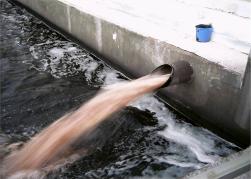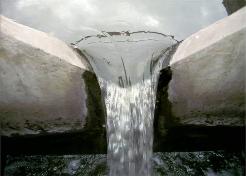- Phone: 800-492-1252
- Fax: 440-368-3569
- E-mail: info@spartanwatertreatment.com
Textile wastewater often has a complex mixture of pollutants. These pollutants can include polymers, organic and inorganic compounds, and color. Textile pollution generates approximately one-fifth of the world’s industrial water pollution. Thus, it is important to reduce pollution with textile wastewater treatment solutions. Ozone has been used successfully for the removal of dye from wastewater of the textile industry. In textile wastewater treatment, ozone is often used in conjunction with biological treatment systems such as activated sludge. Organic dyes are mostly refractory due to their large molecular size and they can be poorly removed by adsorption on activated sludge. In some cases ozone has been used before the biological process, but mainly after biological treatment. If the wastewater is hardly biodegradable or toxic to activated sludge, pretreatment is an option.


Ozone can be used prior to a biological process (1) since it has a tendency to convert organic molecules into smaller more biodegradable species. This can enhance the efficiency of the biological process. In addition, industrial ozone water treatment increases the oxygen content of the water (unconverted oxygen and ozone that decomposes back to oxygen that was mixed with the water) which results in improvement in aerobic processes. While this benefit is well-known in the literature it is difficult to practically apply since the amount of improvement is difficult to predict and pilot studies involving ozone and biological processes are difficult to carry out. In textile wastewater processes, a 20-30% improvement in the action of the biological system has been observed.
The effect of ozone on improving biodegradability and reducing toxicity is worth noting in terms of the effect of the treated water on the receiving stream. Where the treated water is tested for toxicity, the impact of the treatment process on this parameter must be considered. Destroying one organic molecule, but creating more toxic ones in a treatment process has been observed. For example, the ozonation of MTBE without any additional agents or treatment processes can result in a more toxic wastewater. Another consideration is the presence of surfactants and the need to remove these compounds from the water. In some locales, surfactant concentrations are tightly controlled and must be kept under 1 ppm. This creates an additional demand for oxidant. Some textile waste waters contain both color and surfactants.
Ozone is effective in removing the color from all dyes used in textile processing. The amount of ozone can vary depending on a number of factors. One factor is how much color was removed in the biological process. A second factor is the type of dye used. A third factor is where ozone is applied in the process, etc. Knowing the proper amount of ozone required to meet the color removal objective for the receiving water body is critical to the economics of the ozone system. In general, it is not easy to predict the amount of ozone required. This means in virtually all cases where specific previous experience is not available, pilot testing is employed.
Tosik (2) has shown that about 1 mg ozone/mg dye is required to achieve 95% color removal, although this ratio varies by dye type. The ratio increases to about 1.5 for 100% removal. Reaction times were on the order of 10 minutes. In the textile industry, a typical dosage might be 15 mg/l post biological treatment, but the levels could easily reach 25 mg/l. It is important to note that the ozone dose only needs to make the dye compound uncolored and not necessarily completely mineralize the material.
Most industrial ozone generators convert oxygen to ozone using the corona (silent) discharge method. The oxygen can come from dry air, oxygen concentrated from air, or liquid oxygen systems (LOX).
The use of oxygen in an ozone system is dictated primarily by the local economics. The use of oxygen reduces the size of the ozone generator for a given amount of production. Additionally, it lowers the energy requirement and reduces the energy employed in mixing the ozone with water if a venturi style injector is used. This is off set by the cost of LOX, including the LOX storage and evaporation equipment, or the additional compressed air required for the concentration process. As the size of the units increase, oxygen tends to be favored. Oxygen is also favored by high energy costs, but is disfavored when the cost of LOX is high.

An air fed ozone system for a textile wastewater application would include the following components: an air compressor, an air dryer, an ozone generator, an ozone water mixing system and an ozone destruct unit. The use of an air fed system in this example would probably be the worst case for ozone. If the equivalent electrolytic system cannot compete with this type of ozone system, it is probably not economical in general.
The use of dry air is critically important to the successful operation of an ozone generator. Most modern air fed ozone systems employ high pressure air driers which employs the pressure swing adsorption (PSA) method. This eliminates the need for a refrigeration unit as well as a heated desiccant dryer, but increases the pressure required from the compressor to around 100 psi.
Ozone makes up a small percentage of the final gas mixed with the water (2-3% in the case of air and 6-10% in the case of oxygen). A venturi or fine bubble diffusers can be used to mix the gas with the water in order to dissolve the ozone. This excess gas must be disengaged from the water. The use of a venturi type injection system requires a booster pump. Fine bubble diffusers are normally deployed on the bottom of the contact vessel. This can be cheaper since it would eliminate the booster pump and substitute less expensive diffusers for the venturi.
The dissolved ozone must be allowed to remain in contact with the water for a certain period of time so the reaction can go to completion. This time is probably on the order of 10-20 minutes. To achieve this retention time some form of tank or contact vessel is required. This tank can also be employed to allow the gas and liquid disengage. We have taken this approach in costing out the example system below. The gas liquid mixture will enter the tank and the gas will be disengaged from the liquid in the tank.
Since the transfer efficiency for ozone into water commercially varies from 80-95%, a portion of the ozone is found in the vent gas. In some locales, this must be decomposed. An ozone destroyer is employed for this process. It would pull air off the top of the contact vessel.
Industrial ozone systems as discussed above have fairly low installed cost factors since most of the equipment is factory tested and skid mounted. Power, air, water and ozone lines are connected. Typically, the ozone generator and electronics would be housed indoors. The equipment operates in a temperature range of 40-95 degrees F.
1. Removal of Dissolved Organic and color from dying Wastewater by Pre-Ozonation and Subsequent Biological Treatment, Takahashi, Nobuyuki; Kumagai, Tomoyo; Ozone: Science and Engineering, 28: 199-205
2. Dyes Color Removal by Ozone and Hydrogen Peroxide: Some Aspects and Problems, R. Tosik, Ozone: Science and Engineering 27: 265-272